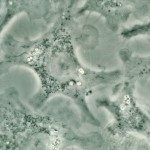Lien vers Pubmed [PMID] – 18564423
BMC Microbiol. 2008;8:97
Invasive aspergillosis, which is mainly caused by the fungus Aspergillus fumigatus, is an increasing problem in immunocompromised patients. Infection occurs by inhalation of airborne conidia, which are first encountered by airway epithelial cells. Internalization of these conidia into the epithelial cells could serve as a portal of entry for this pathogenic fungus.
